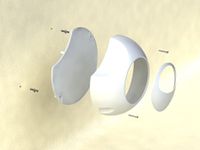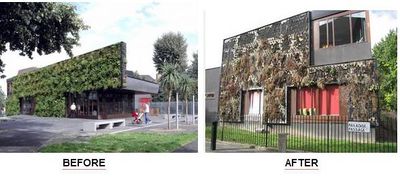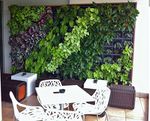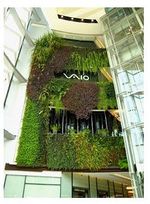Vertical Eden
Introduction of the business idea[modifier | modifier le wikicode]
People love to be surrounded by plants and by nature in general. Apart from fulfilling a specific function (growing food, cleaning the air) plants just appeal to our natural sense of beauty and provide quality of life. Whereas people living outside the city have easier access to either their own garden, a park or natural areas (forests, lakes, etc.) city residents are more restricted.
One solution of combining the quality of life that nature offers with the growing trend of urbanisation are vertical gardens. The idea would be to provide elements that enable people to build a customized vertical garden easily with a single modular product.
At the moment companies provide either very expensive and highly individualised solutions for individual purposes [1] or companies just provide one specific type of product that makes combination or customization for the customer impossible [2].
City residents need a system that can be used inside and outside (balcony, terasse, rooftop) their apartment, that can be easily installed, is adaptable to the space available and fashionable.
Therefore we want to provide modular elements that people can attach to each other. They will be available in a range of beautiful colors. We even want to collaborate with modern artists and exclusively print their design.
Their design could represent a natural structure, as for example honeycombs from bees:


or they could remind people of LEGO and the creative way of how to build one’s own structure:

The elements can be arranged in a way that they are either sell-standing, or they can be attached to a wall or a fence allowing people to make the best use of it.

Due to the many positive externalties of vertical gardens we could have also decided on one of the following contexts for our idea:
Renovation context[modifier | modifier le wikicode]
A lot of old buildings do not meet the standard of modern living anymore. They may be old-fashioned buildings that are not suitable anymore for modern cities but very expensive to tear down. Instead of creating a new building new one some of the old functions could be regained by using vertical gardens.
Urban agriculture context[modifier | modifier le wikicode]
Growing food within city limits, shortening transportation ways, bringing nature to the city, using the space that is not used at the moment (rooftops) A very popular approach to this comes from John Hantz who wants to use urban farming in Detroit to make the city more liveable again, attract new inhabitants and create jobs. Nevertheless, this context would require a very solid and high-tech background as one aim of urban agriculture on a large scale is the efficient exploitation and maximization of harvest.
→ Competition from professional companies with technological background is big [3].
Air-cleaning systems & temperature regulation context[modifier | modifier le wikicode]
We spend most of our time inside (for a office worker easily over 90%) and in a modern house or office, the air inside can actually be 2 to 5 times more polluted than the air outdoors [4] Plants are natural absorber and cleaner of pollutants from the air and could be used as air purifier systems:
- for buildings [5]
- or more general in places that are used by many people and lack good air quality; e.g. trains
→ Competition from professional companies with the technology background is big
Limits of classical business models in this area[modifier | modifier le wikicode]
General limits of volume-based business models[modifier | modifier le wikicode]
The success of the business with this business model depends on the ability to sell more products (volume based business modell.) This can engenders the following problems :
- Planned obsolescence in order to reduce the lifetime of the product
- Incentive to use “cheap” ways of production (materials, labour) to keep margins high and keep the prize affordable for end-users
There are several business models regarding Vertical Gardening, we present the barriers or limits of the traditional ones :
Renting[modifier | modifier le wikicode]
The role of renting business is to provide the structure neccesary for events such as weddings, conferences, home-stagings, and anywhere else a vertical garden is desired.
Limits :
- Transport costs are high for the company because appropiate measures such as special trucks with climatization are required to deliver the merchandise (plants, flowers, soil, structures and water system).
- It is required to hire several employees for installation of the vertical garden which increases costs.
- Investment and maintenance of the products are essential. If a structure, frame, bag, furniture is broken, or plants are dead; those have to be replaced.
Maintenance[modifier | modifier le wikicode]
Just like a gardener there is the business model for maintain vertical gardens. Water, new soil, fertilizers, change of plants, replace of old or broken furniture, and other types of mantainance are needed in order to conserve the vertical garden. Even though maintenance is a source of continuous revenue, and will ensure positive cashflow for the company during periods of few or no sales it has its own limits.
- Maintenance has a direct relationship with weather. In cities with extreme temperatures this business model could not work because lifetime of plants is reduced.
- Storage of big invetories are needed in order to maintain green gardens.
Residential[modifier | modifier le wikicode]
- Residential business model is based on selling vertical gardens to decorate home interior or exterior. Provide elements to costumers in order they can build their own vertical garden at home is a difficult job.
- Most of the times products provided for these organizations are limited and standard, there is not a wide offer of elements.
- Costs get high because it is sold per unit, in contrast with the volume business model.
- Low level of technology required.
Commercial[modifier | modifier le wikicode]
Green walls are the definition of this business model. Enterprises like hotels, known companies, even governments are interested in having green walls in the exterior of buildings or monuments. Some of the limitations are the following:
- In general, the expertise in plants and water system should be wide in this business. Knowledge of building high, temperature, building construction/deterioration, materials, types of plants are important to keep alive the green wall during long time.
- Business to business or business to government is applied.
- Huge warehouse/storage rooms are needed.
- High investment to renew inventory is requiered.
- Maintenance and high technology is included, which increases costs.
Formalization of the business model[modifier | modifier le wikicode]
As vertical gardens lead to a variety of positive externalties, choosing the right context for our product is key. After considering the 5 listed possible areas for our product (decoration, education, renovation, urban farming and air purifying) we decided to focus on decorational and educational aspects of our product.
Your creativity is the limit: “Selling in the old business model”[modifier | modifier le wikicode]
First, the aestetic aspect combined with the easy installment of our product is key . This will help us in the “old” volume-based business modell to reach a certain amount of customers. We aim at creating an interactive relationship with our clients: We want to boost this approach by
- collaborating with modern artists that design “special” editions.
- enable people to share their creations online
- exchange advice & recommendation online
- create an open-source platform where people can suggest new shapes of the product (similiar to LEGO)
As we have already mentioned this approach helps us selling our product but we are still caught in the volume-based business model as we have to sell more in order to grow.
We therefore analyzed which actors (apart from individual b2c-users) would benefit from our current product idea and got aware that public institutions foster the development of green public spaces in their function as role models. We want to concentrate on a specific institution: schools!
Re-establishing the bond between nature and children: “Provide added-value in the new business model”[modifier | modifier le wikicode]
Our product generally allows people to get in contact with nature, to see plants grow and take care of them, use their creativity to attach the individual elements, learn about which plants need which kind of treatment and even allow them to grow their own food/herbs on a small scale.
These are also lessons that a lot of parents want to teach their children. A worldwide trend called forest schools/kindergartens, nature-schools or outdoor schools spreads quickly and already exceeds the number of 1000. Martin Clarke, a teacher at a German forest kindergarten tells The Telegraph that kids receive more than a simple understanding of nature, but better health and coordination.
We want to adress schools with our product. Instead of simply selling our product to schools, we want to teach and offer “a package” around the creation and usage of a vertical garden. We want to transmit knowledge on social skill (working in teams), nature (plants & which kind of attention they need), environmental problems (what are consequences of a “loss of nature”) and health & nutrition (how do I eat healthy, how do vegetables grow).
Creation of a vertical garden:
- teambuilding & teamwork: every student receives one of our elements. In order to create an overall structure the class has to go through the process of teamwork and agree on how they put the individual pieces together.
- the class builds the final structure together on a place the school agrees to and plants eighter decorational flowers or vegetables
They receive lectures on:
- how to maintain the garden (they need to establish roles of who takes care for it: need to take on responsibility) and how to treat the plants
- how to eat healthy and how to cook easy meals
- the importance of nature & sustainability
Illustrate our approach with this video: [1]
The new business model[modifier | modifier le wikicode]
Value Proposition[modifier | modifier le wikicode]
- from a customers’ point of view:
= providing children a balanced education where they also learn about the environment, their health and how to interact with others as well as taking on responsibility. = receiving a “complete package”, not only including the materials for the vertical gardens but coaches and teaching material = enabling the school to be different from other schools; having a “comparative advantage” = satisfying parents’ expectations
The customers’ are the schools directly and in a second step the children that receive the course as well as the parents who are eager that their children get a proper education.
The first type of school we want to address are those who already show interest in outdoor time and nature activities. Those are especially Waldorf, Reggio Emilia and Montessori. Our concept can be integrated in their teaching and fits perfectly their values of self-reflected learning, working in teams, knowledge about environment and sustainability. The parents support these principles as they have already made the decision to put their child in such a school instead of a regular public school.
Public schools are often resistent to change and implementing such programs because most parents are not stepping up to complain or change the system. Nevertheless, a lot of parents are interested in starting school gardens as this guide on getting a school garden started illustrates: [2] The network of actors
- for creating solely the product: suppliers, manufacturers, investors, research departments, designers
- for selling our product to schools: school authorities, parents, children, teachers, “own coaches”
Actors relationship management[modifier | modifier le wikicode]
Especially with the school authorities and the parents we need to establish a relationship of trust. At the beginning of the talks, we need to provide clear information on our aims and how we will reach them. Parents need to be included into this process (either through written material or an own evening of Q&A). After the creation parents and friends could be invited and a small event can be created around the finished garden. Furthermore, we need a network of suitable & legimitate coaches (or do it ourselves).
Accessibility and ability to gasp mentally[modifier | modifier le wikicode]
- Awareness: we need to create awareness to our solution: talk to schools & parents’ representatives. Spread the world via social media. Talk to local authorities for support. Try to raise public awareness via local newspapers.
- Evaluation: We need people to get an impression of the finished product because the cubes without plants are not really appealing. We need to work with images, videos and displaying our product in public places.
- Purchase: We can directly sell our ideas to the school authorities as well as addressing representatives of the parents’ association. In a second step, we can use a similar approach as one of our competitors [6] by enabling parents or school to set up a fundraising page where people can individually contribute a small sum to crowdfund the project.
- Delivery: should contain the products (cubes) + soil, seed, plants directly to the school + coach and appropriate teaching material
- After sales
Key resources[modifier | modifier le wikicode]
- Our products as a foundation for the service
- Network of clients: satisfied & prospect (word of mouth & legitimacy)
- The pedagogic concept including business coaches
Key activities[modifier | modifier le wikicode]
- Selling our product + our pedagogic knowledge: building & teaching
- Expanding to new schools
- Talks with parents & school authorities
Externalities[modifier | modifier le wikicode]
positive externalties:
- Learning experience: co-creation as a team, knowledge about nature, plants & health
- Something tangible in the end: class can invite friends & parents to show their creation
- Just the starting point for a class project: taking care of the garden, eating the fruits
- Improves image of school
- Adds value to school building
negative externalties:
Drivers of productivity[modifier | modifier le wikicode]
How we could improve productivity
Basic products: “Cube”
- produce more with less -> design our products according to eco-design standards
- automatisation, lowering of labour costs, economies of scale, etc.
Service: “Educational Measures”
- flexibility gains: allow employees (coaches) to arrange the meeting with schools & parents flexible
- adoption gains: to work with someone you know and trust. If we do a project for a school director for one class it is possible that he uses our service for other classes of his school as well or recommends us to other schools.
- complementary gains: by including actors that are already in this field:
- maybe we don’t always need our own coaches but can provide the biology teacher the necessary materials or “teach the teacher” how to hold this specific classes and embedd them in his/her subject
- maybe we can work together with the gardener that takes care of the school gardens and include him in the process of creation & maintanance
Specification of the revenue model[modifier | modifier le wikicode]
Structure and stream of costs[modifier | modifier le wikicode]
The first version of the business model was more cost driven, because the , whereas the new business model allow to focus more on value creation by giving children a full experience of vertical gardening.
Fixed costs[modifier | modifier le wikicode]
- Salaries for sales
Variable costs[modifier | modifier le wikicode]
- Manufacturing vertical garden units
- Buying other materials such as soil, plants, ...
- Salaries for trainers
- Transportation costs
Structure and stream of revenues[modifier | modifier le wikicode]
The idea would be to provide units for vertical garden at a low cost for the city including maintenance, and offering offering an educational gardening activity on wednesdays for children. The pricing policy would be dynamic and depend on the customer segment, that could be either the parents of children or schools directly.
Economies of scale[modifier | modifier le wikicode]
The main advantage is that the revenu can be increased by having more persons enrolled in the course (up to a reasonable limit) without having to increase costs.
Justification of the sustainable added value of this business model[modifier | modifier le wikicode]
The new value proposition is sustainable because of the system it provides (more than a service). It is at the cross road of economic, social and environmental. The partner who it serves are also serving Vertical Eden by reciprocity ; including a reduction of cost. More largely for the society, Vertical Eden develops a good image and good sustainable policy for the cities it would work with.
During the « week of the taste » schoolers are taught how to cook. The idea would be be to teach them how to garden up in a brand-new way, and funny one.
By collaborating with them they would get a greener school, learn how to maintain them and for us it would be money savings (maintenance cost reduced). This is a big part of our business model : It is a shared benefits.
The cost structure is value driven : it aims at creating a positive impact in the society, the school and the company. Schools are key partners in order to improve the activity and their is a need to co-create with them.
The key activity is the service provided and not anymore the product itself. Thus, the material value was decreased and the immaterial one increased.
References[modifier | modifier le wikicode]






